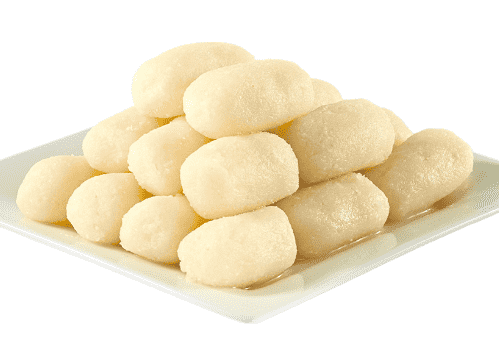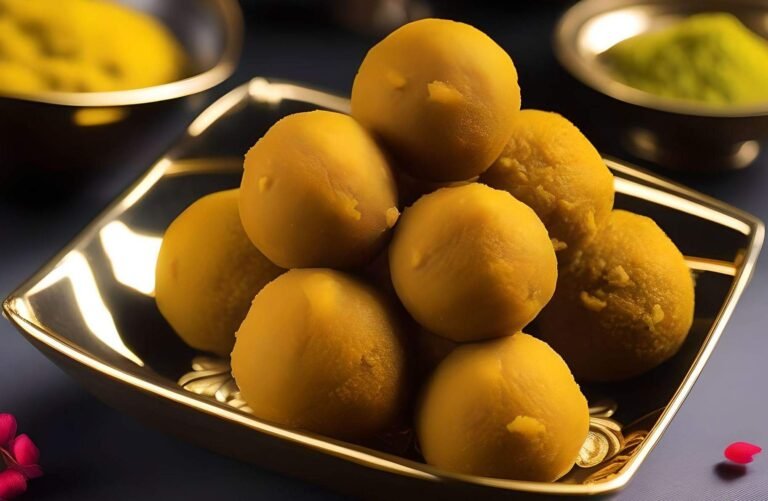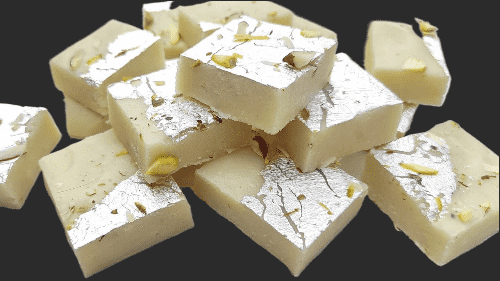1. Best Cham Cham
Introduction:
In this section, we introduce the reader to the world of Cham Cham, providing context about its origins and why it’s such a beloved sweet in Bengal.
What is Cham Cham?
Cham Cham (sometimes spelled Chomchom or Chum Chum) is a traditional Bengali dessert made from fresh chhena (Indian cottage cheese), cooked in sugar syrup, and often stuffed or garnished with coconut and nuts. It’s one of those sweets that represent the soul of Bengal, carrying with it years of tradition and festivity.

The Origin Story
Cham Cham’s origins date back to the early 19th century in Bengal, a time when regional sweet-making was an art form. Legend has it that this sweet was first made in a town called Porabari in Bangladesh. Soon, the dish spread across the Indian subcontinent, becoming a favorite during special occasions, especially weddings and festivals.
Cham Cham vs. Rasgulla: What’s the Difference?
While Rasgulla is a more famous cousin, Cham Cham has its own unique identity. The shape is elongated, the texture is denser, and it is often garnished with coconut and nuts. Unlike Rasgulla, which is round and often served soaked in syrup, Cham Cham can be enjoyed either dry or with syrup, and it can be filled with sweetened mawa.
The Evolution
Traditionally, Cham Cham was made using just a few basic ingredients: milk, sugar, and water. However, over the years, this sweet has evolved into various forms, incorporating food coloring, mawa (milk solids), and even fruit flavors like mango and strawberry.
Why it is the Perfect Sweet for Every Occasion
Here, explore why Cham Cham holds a special place in Indian cuisine and celebrations.
The Symbolism of Cham Cham in Bengali Culture
Cham Cham is more than just a sweet—it’s a symbol of celebration and togetherness. Whether it’s Durga Puja, Diwali, or a wedding, Cham Cham is often presented as a token of love and joy. It represents the essence of Bengali hospitality, where sweets are used to welcome guests.
Versatile and Easy to Personalize
One of the reasons Cham Cham stands out among Indian sweets is its versatility. Whether stuffed with khoya or garnished with dried fruits, it can be adapted to different tastes and preferences. Some even use edible silver leaf (varak) for an extra touch of elegance.
The Science Behind Making Perfect Cham Cham
This section delves into the technical aspects of making it, offering insights on the science behind each step.
Understanding Chhena (Indian Cottage Cheese)
Chhena is the foundation of Cham Cham. Its quality directly impacts the texture of the sweet. Chhena is made by curdling milk with an acidic agent like lemon juice or vinegar, separating the whey from the milk solids. The key to soft Cham Cham is ensuring the chhena is kneaded to the right consistency—soft but not sticky.
The Importance of Kneading
Kneading the chhena is arguably the most critical step in making Cham Cham. The process helps to remove excess moisture while ensuring that the chhena is smooth and pliable. If not kneaded properly, the Cham Cham might turn out hard or crumbly.
Sugar Syrup and Its Role
The sugar syrup used to cook Cham Cham is fundamental. The right concentration of sugar and water ensures that the Cham Cham pieces cook evenly while retaining moisture. Too thick a syrup can make the Cham Cham overly sweet and dense, while too thin a syrup may prevent the sweets from absorbing enough sweetness.
Cooking Time and Temperature
The cooking process is delicate. The Cham Cham pieces are simmered gently in syrup for around 15-20 minutes, during which they expand and absorb the syrup’s sweetness. If the heat is too high, they can become rubbery; too low, and they won’t cook evenly.
Cham Cham Recipe: Step-by-Step
This section covers the detailed recipe, enriched with extra tips and potential pitfalls to avoid, to ensure the reader can make the perfect Cham Cham every time.
Preparing the Chhena (Cottage Cheese)
Ingredients:
- 1 liter full-cream milk
- 1 tablespoon lemon juice or vinegar
- 4 cups water for the syrup
- 1 cup sugar
- 1/2 teaspoon cardamom powder
- Boiling the Milk: Use full-fat milk for the richest texture. Bring the milk to a boil, ensuring that you stir it occasionally to prevent it from sticking to the bottom.
- Curdling the Milk: Add diluted lemon juice or vinegar once the milk starts boiling. Stir continuously until curds form and the whey separates. Turn off the heat immediately to avoid over-curdling.
- Straining and Washing the Chhena: Use a muslin cloth to strain the curdled milk. Rinse it under cold water to remove the acidic taste of lemon or vinegar. Press the chhena gently to remove excess water, but don’t over-squeeze, as some moisture is essential for soft Cham Cham.
- Kneading the Chhena: Transfer the chhena onto a clean surface and knead it for about 8-10 minutes. The key is to achieve a smooth, lump-free dough. Over-kneading can make the chhena too soft, leading to flat Cham Cham, while under-kneading can make them hard.
Shaping It :
- Forming Cylindrical Shapes: Divide the chhena into equal parts and shape them into elongated, cylindrical pieces. Traditionally, Cham Cham has an oval shape, but you can experiment with round or even heart shapes for special occasions.
- The Sugar Syrup: Boil 4 cups of water with 1 cup of sugar and add a hint of cardamom powder. The sugar syrup should be just sweet enough, not overly concentrated.
- Simmering the Cham Cham: Gently place the shaped chhena into the boiling syrup. Cover and cook for 15-20 minutes. The Cham Cham should double in size as they cook. Avoid overcrowding the pan to ensure even cooking.
- Cooling in the Syrup: After cooking, let the Cham Cham cool in the syrup for at least 30-60 minutes. This allows them to absorb more sweetness and develop a spongy texture.
Adding a Unique Twist with Filling and Garnish
- Stuffing with Mawa: Prepare a mixture of mawa, powdered sugar, and cardamom powder. Slit the cooled Cham Cham lengthwise and fill them with this creamy mixture for a richer flavor. You can also experiment with flavored fillings such as rose-flavored mawa or even chocolate.
- Coconut and Nuts Garnish: Roll the stuffed Cham Cham in desiccated coconut and top with finely chopped pistachios, almonds, or cashews. The garnish adds a delightful texture contrast to the soft and spongy sweet.
Common Mistakes to Avoid
In this section, we cover common pitfalls and how to avoid them, giving readers the confidence to perfect their Cham Cham.
- Curdling the Milk Too Quickly: Adding lemon juice too fast can lead to grainy chhena. Always dilute the acidic agent with water and add it slowly while stirring.
- Over-Kneading the Chhena: Over-kneading will cause the chhena to become too soft and sticky, which might result in flat Cham Cham.
- Improper Sugar Syrup: Too thick or too thin syrup can affect how well the Cham Cham absorbs sweetness. Ensure a balanced syrup consistency.
- Cooking at High Heat: High heat can make the Cham Cham rubbery. Always cook on medium heat and let the sweets simmer gently.
Variations:
Here, we explore different creative versions of Cham Cham, appealing to a wider audience.
- Saffron Cham Cham: Infuse saffron strands into the syrup to give your Cham Cham a luxurious golden hue and distinct flavor.
- Mango Cham Cham: For a tropical twist, add a layer of mango puree to the filling or use mango pulp in the syrup.
- Chocolate Cham Cham: Dip the cooled Cham Cham in melted chocolate for a fusion dessert.
- Rose and Pistachio Cham Cham: Use rose essence in the filling and garnish with rose petals and pistachios for a fragrant, floral version.
The Cultural Significance
- We wrap up with a reflection on the role Cham Cham plays in Bengali festivals, weddings, and celebrations. Whether it’s a gift during Durga Puja or a sweet treat for guests at a wedding, Cham Cham is integral to Bengali hospitality.
- Cham Cham as Prasad: During festivals like Durga Puja, It is often offered as prasad (blessed food) to the gods and shared with devotees.
- Wedding Sweet Boxes: Bengali weddings often include Cham Cham in the array of sweets sent to the bride’s and groom’s families. It’s a symbol of sweetness and auspiciousness.
Conclusion:
In the conclusion, invite readers to try this authentic recipe, emphasizing the joy of bringing Bengali tradition into their kitchens. It is more than just a dessert; it’s an experience that reflects the rich culture and culinary heritage of Bengal.






Как купить аттестат 11 класса с официальным упрощенным обучением в Москве
Диплом вуза купить официально с упрощенным обучением в Москве
Как избежать рисков при покупке диплома колледжа или ПТУ в России